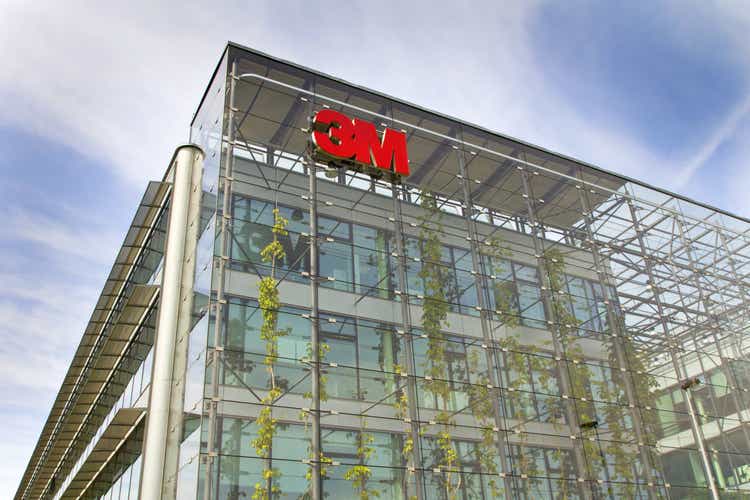josefkubes
Investment Thesis
3M (NYSE:MMM) is a technology and materials company, and a leading manufacturer in multiple sectors. Manufacturing over 50,000 products, 3M is present in everyday life whether or not you realize. With 100+ years of paying dividends, and 64 consecutive years of increases, we firmly believe that 3M is a worthy investment for its yield and growing dividend.
While 3M is seeing some margin compression due to material and logistics shortages, it managed to increase the cash returned to shareholders by 50% year over year in 1Q22 – a 64th consecutive year of dividend increases. Additionally, as a part of strategic repositioning, capital expenditures are up 37% year over year, while increasing net debt by only 2%.
Estimated Fair Value (EFV)
EFV = E2023 EPS of $11.70 times PE of 15 = 11.70 X 15 = $175
|
3M |
E2022 |
E2023 |
E2024 |
|
Price-to-Sales |
2.3 |
2.2 |
2.2 |
|
Price-to-Earnings |
13.5 |
12.8 |
12.2 |
|
Estimated Yield |
4.1% |
4.3% |
4.3% |
Operations
3M breaks down its operations into four business segments, safety and Industrial, Transport and Electronics, Healthcare, and Consumer. 3M products are often sold directly to OEMs or contractors, but also directly to retailers and wholesalers for consumer-grade products.
3M has seen some margin compression in recent quarters, especially under their segments that primarily sell to OEM manufacturers such as electronics and EV makers. Other raw material shortages and logistics challenges also continue to compress margins, but the decrease in COVID-19-related fears has begun to give tailwinds in the Healthcare sector.
|
Safety and Industrial |
Transportation and Electronics |
Healthcare |
Consumer |
|
|
Products |
|
|
|
|
|
Uses |
|
|
|
|
|
Current Trends in the market, or opportunities |
|
|
|
Safety and Industrial saw only 0.5% organic growth but maintained an operating margin of 22.9%. Largely, this is due to disposable respirator sales decreasing (by 8% year over year, decreasing growth by 1.5%). Additionally, 3M is impacted by logistics and raw material shortages that are affecting the global economy presently; while this is partially offset by price increases, the operating margin has been hit by a negative 3.5%.
Transportation and Electronics saw a contraction of 0.3%, due to the semiconductor shortage hitting growth by an estimated 5%. Additionally, this had adverse effects on operating margin of 2%, reducing it to 21.2%. However, as the semiconductor production bottleneck is eliminated, 3M expects to see tailwinds in Electric Vehicles (EVs), automation, and consumer electronics.
Healthcare saw 4.7% organic growth, with a 21.1% margin. COVID-19 continues to adversely affect elective procedure volumes, with 10-15% of patients choosing not to undergo procedures due to Omicron concerns. However, this is fading quickly, and 3M expects this to return to 95% pre-COVID levels by end of 2Q22. Additionally, the wind-down of COVID-19 means that 3M will need to lower its cost in healthcare after the COVID cross currents.
The consumer division saw 3.4% growth with a 17.1% operating margin. But, again, due to logistics and material shortages, 3M experienced some margin compression of 3.7% in the sector.
Outlook
3M currently has 3 declared strategic priorities: portfolio management, transforming the model, and growth through innovation.
Portfolio management is primarily focused on repositioning of resources. Namely, divesting from products that no longer fit into 3M’s business model, optimizing costs for existing businesses, and repositioning capital into new investments. An example is moving healthcare to a more cost-conscious footing in a post-COVID world.
Transforming the model and growth through innovation is essentially accretive acquisitions of promising products or patents that will add value, without driving up costs, compressing margin, or otherwise disrupting existing business.
Risk
Currently, COVID-19 remains a present concern especially in China where their “zero-COVID” policy is locking down entire cities which negatively hits the global economy since China is a global manufacturing center.
However, 3M is optimistic with end-markets being strong including automakers increasing orders by 4% year over year, and smartphone manufacturers increasing orders by 2% year over year. Obviously the semiconductor shortage remains a problem, but we expect the semiconductor shortage should begin to ease in 2H22, with the broader shortage ending “at some point” in 2023.
3M is under litigation for various products, however a military contract in which it provided millions of pairs of later-to-be-proven defective earplugs to servicemen and women. 290,000 veterans have filed action. JPMorgan Analysts have determined that the potential liability of this is around $1 billion based on the current 30% victory rate and $17 million average payout so far. However, total sought damages against 3M are nearly $1.5 trillion.
There is also the PFAS litigation, which is ongoing. PFAS is a chemical used in nonstick cookware, as an antimicrobial coating, and as firefighting foam among other things. It is called a “forever chemical” because it lingers in the environment for a time past the human lifespan, and recent research has shown it does indeed have health risks. Thus far, 3M has settled $550 million of these cases – the actual amount of damage that 3M may be liable for is difficult to calculate.
Additionally, 3M is targeting carbon neutrality by 2050, already reducing emissions by 26% and reducing petroleum usage by over 18 million lbs. On top of this, 3M is spending $32 million (excluding PFAS) to clean up former or current 3M manufacturing locations which may have leaked hazardous substances.
Conclusion
Despite a not insignificant level of headwinds and the ever present legal risk, we still believe that due to the massive expanse of 3M’s product portfolio and long history of delivering quality products, it is a good choice for a solid dividend yield on a blue-chip.
Even with an increase in capex and margin compression, 3M has had a 64th annual dividend increase at 4.0% yield and has only increased net debt by 2% year over year.


Be the first to comment